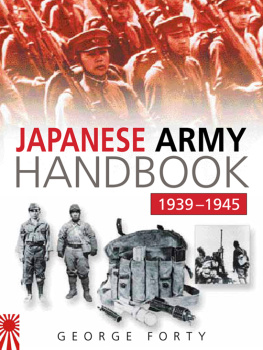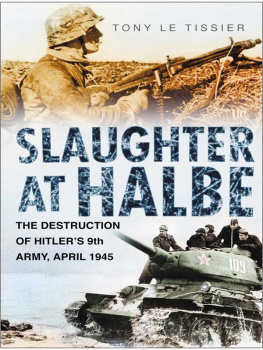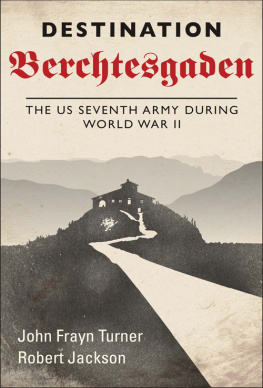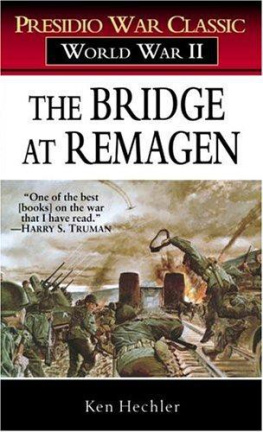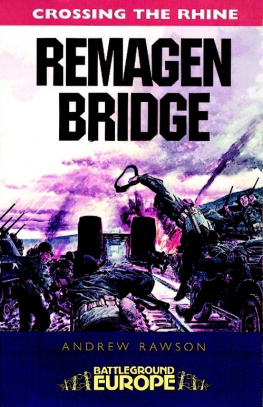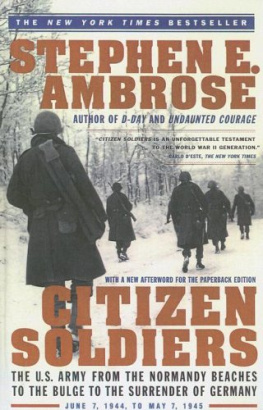This edition is published by PICKLE PARTNERS PUBLISHINGwww.pp-publishing.com
To join our mailing list for new titles or for issues with our books picklepublishing@gmail.com
Or on Facebook
Text originally published in 1948 under the same title.
Pickle Partners Publishing 2016, all rights reserved. No part of this publication may be reproduced, stored in a retrieval system or transmitted by any means, electrical, mechanical or otherwise without the written permission of the copyright holder.
Publishers Note
Although in most cases we have retained the Authors original spelling and grammar to authentically reproduce the work of the Author and the original intent of such material, some additional notes and clarifications have been added for the modern readers benefit.
We have also made every effort to include all maps and illustrations of the original edition the limitations of formatting do not allow of including larger maps, we will upload as many of these maps as possible.
THE REMAGEN BRIDGEHEAD, MARCH 7-17, 1945
PREPARED BY
RESEARCH AND EVALUATION DIVISION
THE ARMORED SCHOOL
Remagen Bridgehead. Photographed March 27, 1948 for the Historical Division SS USA by the 45 th Reconnaissance Squadron under the supervision of Major J.C. Hatlem
TABLE OF CONTENTS
Contents
PREFACE
The purpose of this study is to collect all available facts pertinent to the Remagen Bridgehead Operation, to collate these data in cases of conflicting reports, and to present the processed material in such a form that it may be efficiently utilized by an instructor in preparing a period of instruction. The data on which this study is based was obtained from interviews with personnel who took part in the operation and from after action reports listed in the bibliography. This is an Armored School publication and is not the official Department of the Army history of the Remagen Operation. It must be remembered that the Remagen Operation is an example of a rapid and successful exploitation of an unexpected fortune of war. As such, the inevitable confusion of facts and the normal fog of war are more prevalent than usual. The absence of specific, detailed prior plans, the frequent changes of command, and the initial lack of an integrated force all make the details of the operation most difficult to evaluate and the motives of some decisions rather obscure. The operation started as a two-battalion action and grew into a four-division operation within a week. Units were initially employed in the bridgehead, as they became available, where they were most needed: a line of action that frequently broke up regiments. In cases of conflicting accounts of the action, the authors of this study have checked each action and each time of action included in the study and have evaluated the various reports in order to arrive at the most probable conclusions.
FOREWORD
The following comments are included in this study of the operation for the benefit of those who will follow and who may be confronted with the responsibility of making immediate, on-the-spot decisions that are far-reaching in their effect and that involve higher echelons of command.
The details of the operation are valuable and should be studied, as many worthwhile lessons can be learned from them. In this study, which should be critical, the student should approach them by Working himself into the situation; that is, by getting a clear mental picture of the situation as it existed at the time it took place.
First and foremost, the operation is an outstanding proof that the American principles of warfare, with emphasis on initiative, resourcefulness, aggressiveness, and willingness to assume great risks for great results, are sound. The commander must base his willingness to assume those great risks upon his confidence in his troops.
Commanders of every echelon from the squad up who take unnecessary risks that are rash, ill-conceived, and foolhardy should be removed from command.
Hence the need and value of good training.
In this particular operation the entire chain of command from the individual soldier, squad, platoon, and on up through the highest echelon, SHAEF, saw the opportunity and unhesitatingly drove through to its successful execution.
It is impossible to overemphasize this as an illustration of the American tradition and training.
Military history is replete with incidents where wonderful opportunities were not grasped, with resultant failure.
The fact stands out that positive, energetic actions were pursued to get across. The traffic jams, the weather, the road nets, the change in plans, did not deter anyone from the primary job of getting across the Rhine and exploiting this wonderful opportunity.
The results are history.
One other thought. When a reporter asked Sergeant Drabick, the first soldier across the bridge, Was the seizing of the bridge planned? I don't know about that, all I know is that we took it, was his reply.
This sums it up in a nutshell. So much for the operation.
It might be well for future value to surmise what would have happened if the operation had failed. Assume for this purpose that 24 or 36 hours after the initial troops crossed, the bridge had gone down from delayed time bombs or from air bombing or the direct artillery fire, which was extremely accurate the first few days. It actually did collapse on 17 March.
Those troops already across would have been lost.
Would the commanders who made the decisions have been severely criticized?
My purpose in this question is to create discussion. My hope is that your thinking will result in the answer that they would not.
Commanders must have confidence not only in those under their command but also in those under whom they serve.
In this specific case we had this confidence.
JOHN W. LEONARD
Major-General, USA
Formerly Commander, 9 th Armd Div
INTRODUCTION: SEIZURE OF THE LUDENDORFF BRIDGE
Remagen bridge
At 071256 March 1945, a task force of the United States 9 th Armored Division broke out of the woods onto the bluffs overlooking the RHINE RIVER at REMAGEN (F645200)
About 062300 March the III Corps commander, Major-General Milliken, had remarked to Major-General Leonard over the phone, You see that black line on the map. If you can seize that your name will go down in history, or words to that effect. This referred to the bridge.
The plan of assault as formulated by the column commander and as subsequently executed was an attack on REMAGEN (F6420) by one company of dismounted infantry and one platoon of tanks followed by the remainder of the force in route column and supported by assault guns and mortars from the vicinity of (F633204).
As enemy troops and vehicles were still moving east across the bridge at the time (1256), the column commander requested time fire on the bridge with the dual purpose of inflicting casualties and of preventing destruction of the structure. This request was refused due to the difficulty of coordinating the infantry and artillery during the assault on the town.
Company A, 27 th Armored Infantry Battalion, moved out at 1350 following the trail which runs from (F629204) to (F635204). At 1420, the 90-mm platoon of Company A, 14 th Tank Battalion, left the woods at (F632204) and started down the steep, twisting, tree-lined road that enters REMAGEN at (F639201).




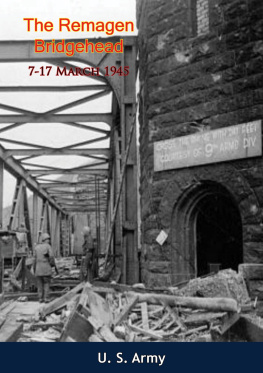
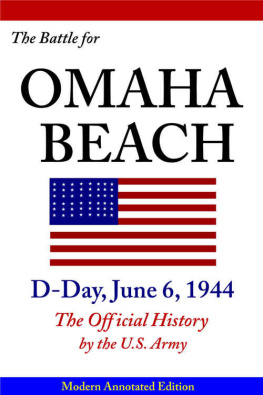

![Walter Shaw Sparrow - The Fifth Army In March 1918 [Illustrated Edition]](/uploads/posts/book/291199/thumbs/walter-shaw-sparrow-the-fifth-army-in-march-1918.jpg)
